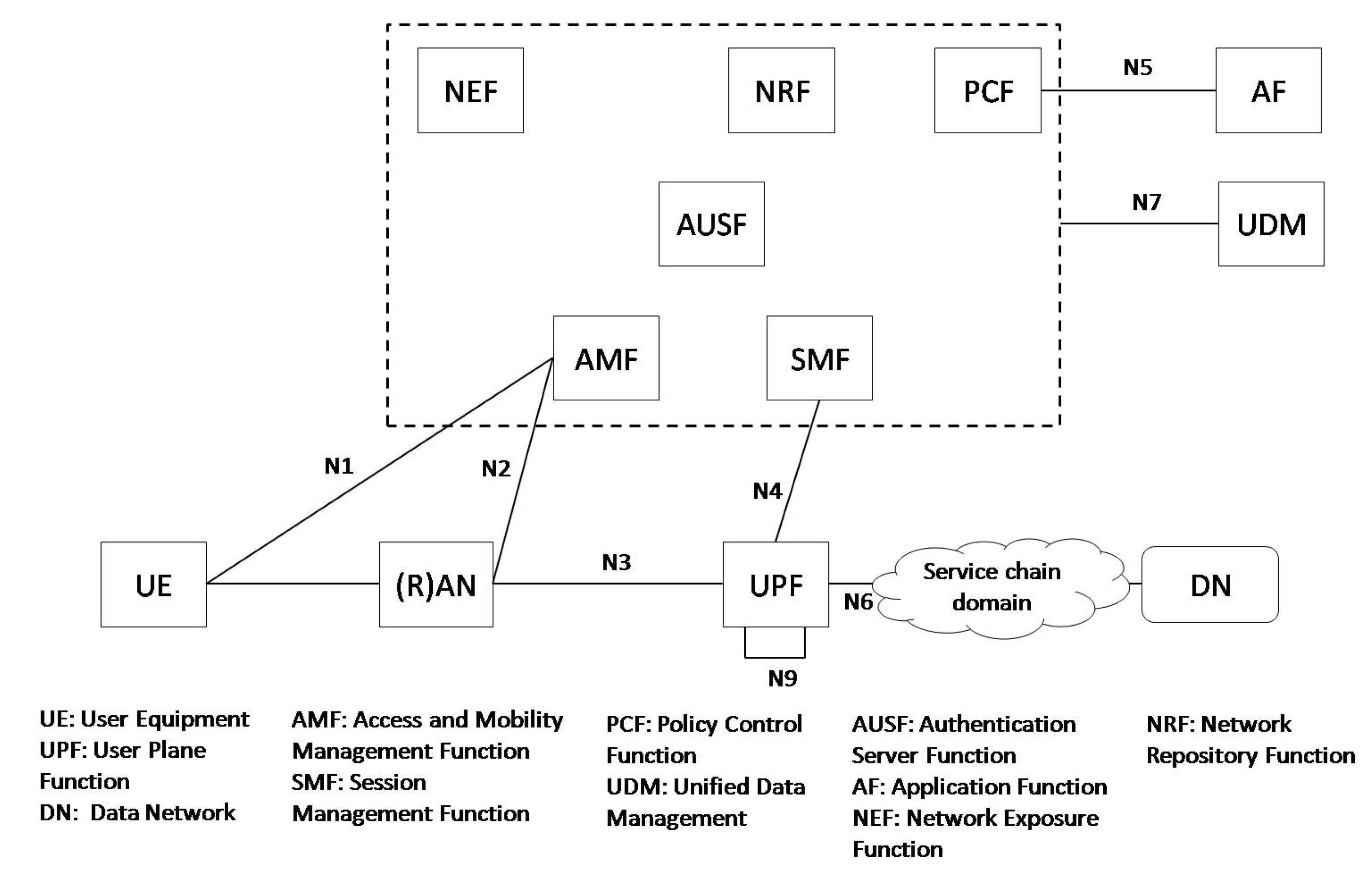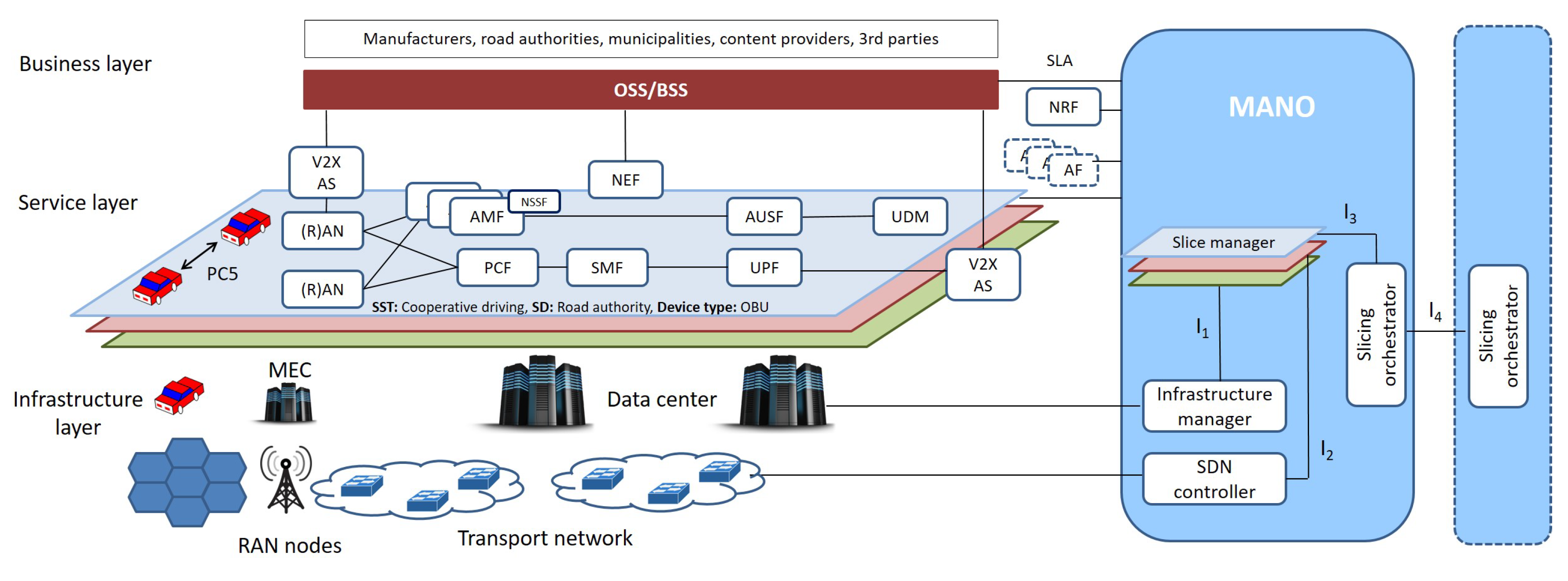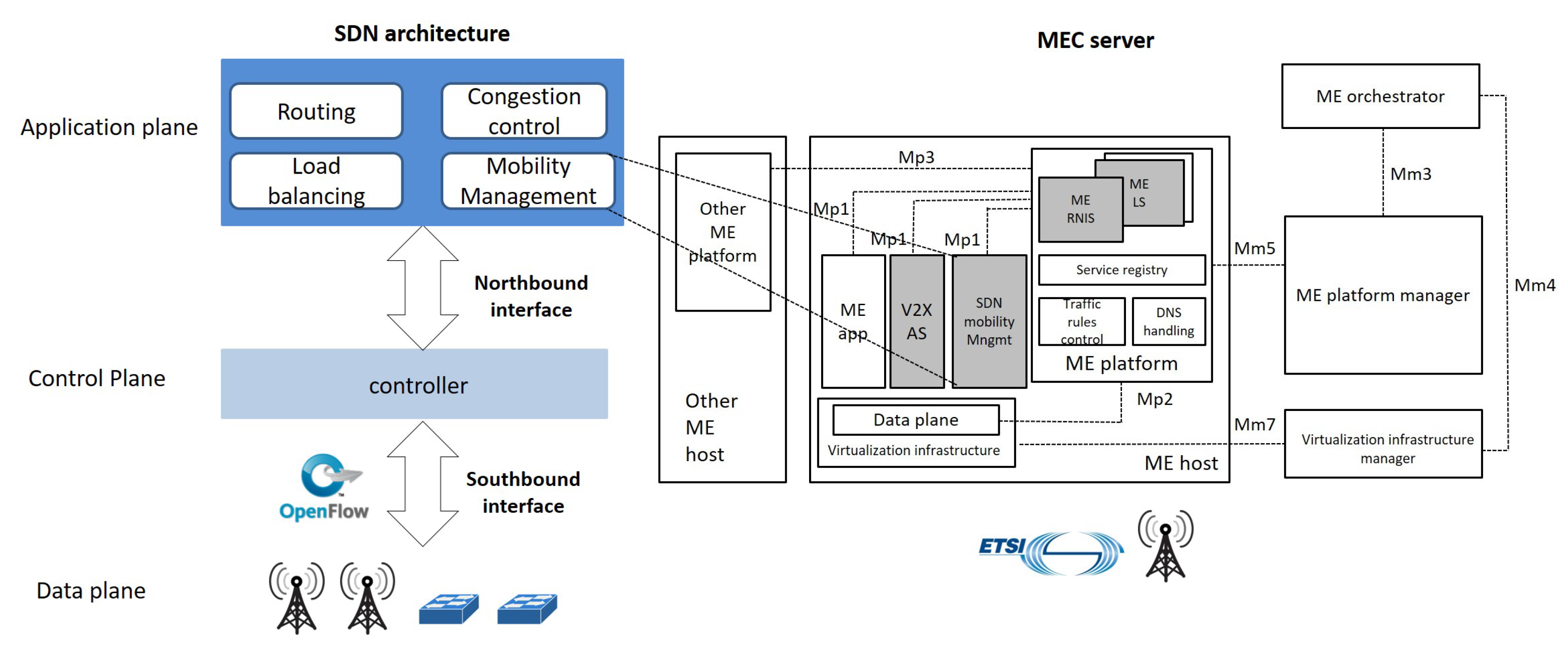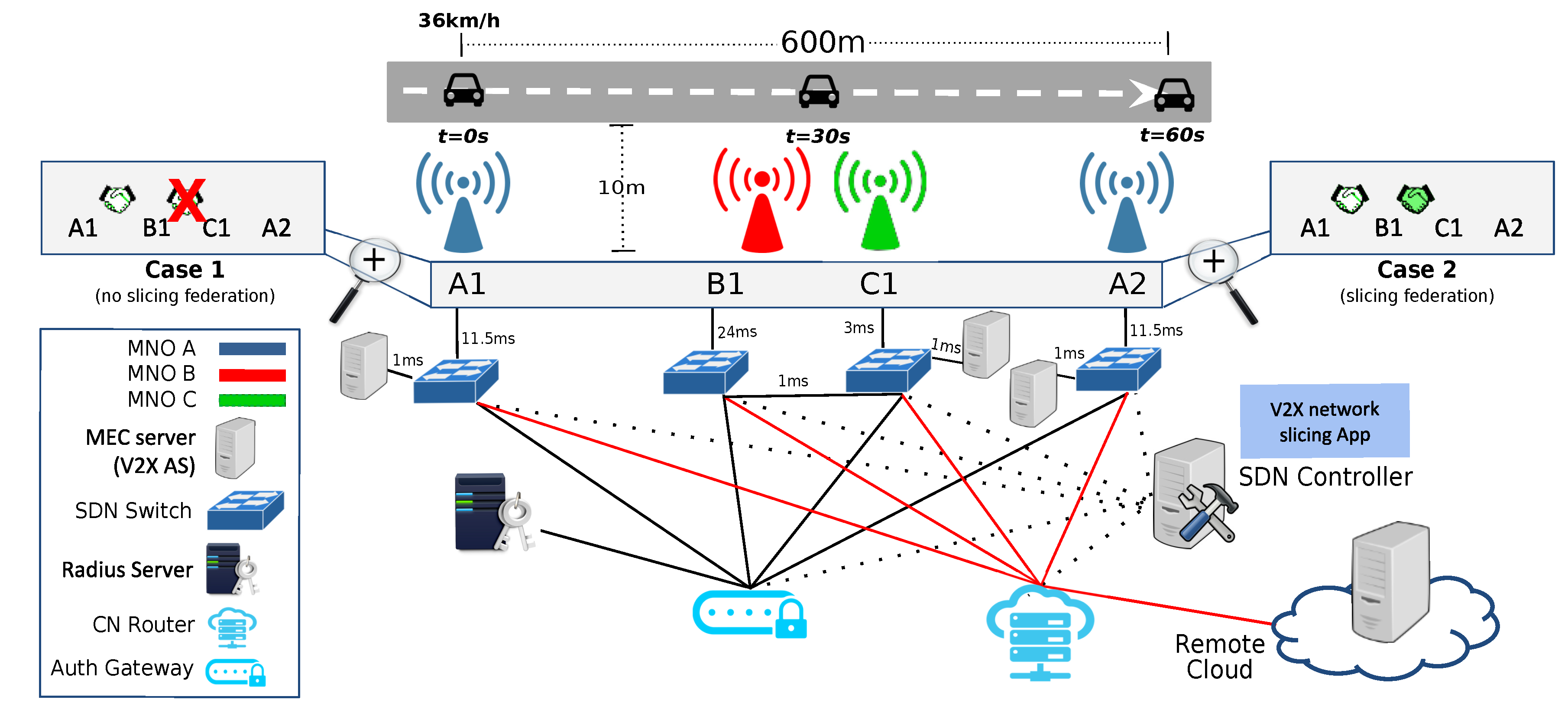Slicing on the Road: Enabling the Automotive Vertical through 5G Network Softwarization
Abstract
1. Introduction
- Localized broadcast communications and edge-dominated access should be considered as crucial slice behaviors to support cooperative driving applications demanding ultra-low latency and ultra-reliable connectivity over the RAN.
- Besides safety applications, having as ultimate goal autonomous driving, multiple heterogeneous services with diversified requirements should also be simultaneously supported (e.g., high-bandwidth infotainment services and diagnostics services) pushing for strict slice isolation.
- The high mobility of vehicles makes frequent roaming events calling for multi-operator slice coordination. To guarantee a consistent user experience in case of roaming, a basic set of functionalities of a V2X slice that cover the main requirements (e.g., mobility and authorization/authentication) should be agreed among operators and proper interfaces conceived for their interactions. In so doing, slices composed of the same network functions/behaviors could be available for the user when moving to a visited network, while ensuring service continuity.
- Design of an architectural framework to support V2X network slicing, aligned with the latest 5G specifications. The framework neatly points out the role and impact of the MEC paradigm and the potential of its interplay with other network softwarization technologies, i.e., SDN and NFV. The behavior is analyzed with special focus on the roaming procedures for a V2X slice supporting the challenging cooperative driving use case.
- Experimentally demonstrate the capabilities of a programmable, multi-access, edge-dominated network infrastructure to support V2X slices, through Proof-of-Concept (PoC) experiments based on the Mininet-WiFi [18] wireless SDN emulator. We overhauled Mininet-WiFi to resemble the main components and mechanisms of the conceived network slicing framework. The results of the reproducible experiments point to the viability of the proposal and the potential benefits.
2. Background, Motivation, and Contributions
2.1. From Cellular-V2X to the 5G Service-Based Architecture
- The V2X Control Function is the logical function for V2X network-related actions. It provides configuration parameters for VUEs located under the coverage of an eNodeB as well as out-of-coverage, i.e., without the cellular infrastructure service.
- The V2X Application Server (AS) has a wide range of functionalities including: the reception of uplink unicast data from the VUEs; the delivery of data to the VUEs in a target area using unicast and/or multicast interfaces. It may also provide centralized control and distribution of traffic, road, and service information.
2.2. Network Slicing for V2X Communications
2.3. Contributions
- A 5G-V2X network slicing framework is designed that enables the interplay of the MEC, SDN and NFV paradigms for the automotive vertical context. The high-level structure is inspired by a widely accepted three-layer architecture, but we make the effort to specify and customize to the V2X case the involved entities, their roles, and the mechanisms required to orchestrate the lifecycle and the behavior of V2X slices with a focus on the cooperative driving service.
- Special attention is given to the way of handling cross-operator interaction that is crucial for V2X due to mobility of vehicles. Specifically, the concept of federated slicing is considered vital to manage the roaming procedures for the V2X slice.
- Some reproducible PoC experiments are implemented through the Mininet-WiFi [18] wireless SDN emulator, which has been overhauled to demonstrate the designed framework capability of supporting the challenging case of cooperative driving in a multi-operator environment.
3. 5G-V2X Network Slicing Architecture
3.1. Architecture Components
- RAN Nodes and devices. Heterogeneous RAN technologies characterize the V2X scenario, including Wi-Fi APs, RSUs, and eNodeBs. We consider all network devices as SDN-enabled switches managed by SDN controllers.
- MEC servers. They host network functionalities and applications that require ultra-low latency access. We refer to the European Telecommunications Standards Institute (ETSI) framework, as a reference for their deployment [33]. There, the MEC server is referred to as Multi-access Edge (ME) host [33]. It is an entity that contains the ME platform and a virtualization infrastructure which provides compute, storage, and network resources for the ME applications. The latter are running, e.g., as virtual machines (VMs) or containers, on top of the virtualization infrastructure provided by the ME host. They can interact with the ME platform to consume and offer ME services. To match the requirements of delay-critical and/or bandwidth-demanding V2X slices, we propose to deploy the V2X AS, normally placed in remote clouds, as an ME application running in the ME host. The ME services Radio Network Information Service (RNIS) and Location Service (LS), envisioned by ETSI [33] (see Figure 3, right), can also play a role for V2X slicing by providing radio-related information, i.e., low-level signaling, helpful to provide radio-related augmented services and to determine the location of a connected device.
- Transport Network. The SDN-enabled transport network interconnects CP and UP Virtual NFs (VNFs) and Physical NFs (PNFs), in the RAN and CN, among each other and with external data networks. SDN is used to steer traffic between NFs of a given slice through the set-up of paths that can be automatically reconfigured either to handle traffic engineering requirements or to react to possible network failures and changing conditions (e.g., mobility).
- Slice Manager. It operates at a per-slice level and is responsible for: (i) slice description through well-defined templates; (ii) slice instantiation, which encompasses the identification of CP/UP architecture, interfaces, slice-specific and common VNFs/PNFs, and RAN/CN/device parameter settings; and (iii) slice life-cycle management, which entails slice configuration, adaptation and monitoring to fulfill isolation constraints and agreed SLAs.
- Slicing Orchestrator. It enables the brokering of resources (hosted in the device, at the edge, on the network and on the cloud) among multiple slices of the same operator. It interacts with the NRF to build the service/network chains by leveraging off-the-shelf NFs and additional AFs, if required. V2X services, especially safety ones, should be supported over unfettered geographical coverage with available resources irrelevant of the specific operator. Thus, it is vital that the slicing orchestrator also exchanges information with peer entities of other Mobile Network Operators (MNOs) to enable seamless platform sharing among operators at a global scale for continuous and guaranteed user experience, according to the federated network slicing concept, under discussion within different standardization bodies (e.g., 3GPP [34] and GSMA [35]) and particularly challenging for V2X due to frequent roaming events.
- SDN Controller. Network resources are managed by logically centralized and physically distributed SDN controllers (Figure 3, left) dealing with traffic engineering functions, network statistics monitoring and implementing southbound interface protocols, e.g., OpenFlow (OF) [36], to install flow-level rules in SDN-capable nodes. Vehicle mobility poses serious issues to the run-time configuration of a slice. Quick path resource allocation algorithms in the backhaul/fronthaul segments are needed to allocate network resources and migrate NFs in another area, while reducing disruption periods. With MEC servers, live migration and service redirection are necessary actions, which further increase the mobility management and handover complexity [37]. To this purpose, a SDN mobility management application becomes crucial to collect radio-related data (e.g., received signal strength), the load status of each RAN node, and information about the position/trajectory of each vehicle, as provided by ME services. To ensure low-latency operation and facilitate the interaction with the ME services, the SDN mobility management network application can be transferred to the MEC server, as also suggested in [37]. Such a design choice, illustrated in Figure 3 (right), emphasizes the potential of the synergy between MEC and SDN in coping with the V2X challenges. Through the collected information and the up-to-date network state, the mobility management application can trigger: (i) seamless UP/CP functions migration (also their pre-fetching, whenever possible); (ii) network resources reconfiguration in the active slice(s); and (iii) handover procedures, e.g., according to the actual load status of each cell, instead of only considering Received Signal Strength Indicator (RSSI).
- Infrastructure Manager. It is in charge of orchestrating the infrastructure layer, by monitoring the processing and storage status of edge and cloud servers. To this purpose, it can build upon the ETSI NFV framework [38].
3.2. Interfaces
- Interface . First, information about the available computing resources are exposed through such interface by the Infrastructure Manager to each Slice Manager. Second, it serves the configuration of such resources as demanded by each Slice Manager.
- Interface . It serves the monitoring of available network resources per slice, as tracked by the SDN Controller, and the specification of network requirements by each slice.
- Interface . It exposes the per-slice requirements to the Slicing Orchestrator and the decision about reserved resources to each slice.
- Interface . It allows the Slicing Orchestrator to interact with its peers of other MNOs.
4. V2X Slice Design
- AMF instances should be available regardless of the specific offered V2X service, to support vehicle mobility. Multiple dedicated AMF instances need to be flexibly deployed to avoid the AMF to be overloaded with consequent increase in latency during slice selection/attachment procedures (being such procedures managed at the AMF), while ensuring isolation with other (non-V2X) slices leveraging the same functionalities but less aggressively (e.g., pedestrian/indoor UEs).
- AUSF, PCF and UDM should be deployed as NFs, which are common to all V2X slices.
- Ultra-reliable and ultra-low latency V2V communications. V2V communications are leveraged to support the reciprocal exchange of vehicles’ kinematics parameters, the perceived environment and intended maneuvers. Dedicated bandwidth can be allocated to V2V links (e.g., 10 MHz as assumed in [19]) to ensure the isolation from other non-V2X slices in the RAN. A common unlicensed spectrum, i.e., the 5.9 GHz Intelligent Transportation Systems (ITS) spectrum, should be used for V2V communications to ensure cross-operator availability.
- V2N communications with the V2X AS. The following data need to be exchanged via V2N links with high reliability and low-latency: (i) raw sensory data sent by vehicles to the infrastructure for the purpose of 3D-map processing of the surrounding area and buildings; and (ii) the computed result sent in the opposite direction to extend the spatial vehicle perception [39]. Therefore, processing shall be carried at an edge cloud level. Multiple RATs and high-throughput connectivity options (e.g., mmWave links) could be used to boost the RAN throughput.
5. Mobility Management
6. Proof-of-Concept Experimental Evaluation
6.1. Implementation Choices and Details
- Vehicles were emulated as multi-interface wireless hosts capable of connecting to both eNodeBs and APs/RSUs.
- Heterogeneous RATs were modeled by configuring range and data rates of (R)AN nodes so to resemble either eNodeBs or Wi-Fi APs/RSUs, deployed by different MNOs as OF-capable switches, connected to the backbone and to nearby MEC servers.
- V2X ASs can be hosted either at a MEC server or in remote cloud facilities. In both cases, they were modeled as wired hosts.
- A Remote Authentication Dial-In User Service (RADIUS) server protocol (FreeRadius provides a multi-protocol policy server, supporting RADIUS, DHCPv4 and VMPS, and is available online: https://freeradius.org/) was used for Authentication, Authorization, and Accounting (AAA) purposes, resembling the behavior of the NSSF when interacting with the AUSF and UDM to check subscription information during the slice attachment procedures.
- As for the SDN Controller, Ryu (It was chosen due to Python programming friendliness and OpenFlow 1.3 support, including metering functionality to measure and control the rate of packets allowing to enforce rate limiting for roaming users; the code is available at: https://github.com/ramonfontes/ryu) was properly extended to run the network slicing and mobility management applications conceived to support V2X. More specifically, it processes radio control information by vehicular devices and tracks their connectivity and position. Based on collected information, the V2X slicing SDN application triggers the service migration (Please, note the simplification compared to the theoretical framework, where this functionality is implemented by the Infrastructure Manager) and configures the interfaces/links to be used for endpoints communication.
6.2. Reference Scenario 1: Slice Capacity Aggregation
- Case 1 (No slicing federation). MNO B accepts the roaming vehicle and allocates a default V2X slice with the available resources, without disrupting the customer active slices but at the expenses of poorer quality. Since MNO B does not host the V2X AS in its MEC facilities, the vehicle is forced to connect to a remote V2X AS, and, hence, experiences larger latencies. In particular, the SDN controller handling the subscription information of the roaming vehicle (as tracked by the RADIUS server) applies the corresponding datapath (OF metering) rules to limit the bandwidth to 5 Mbps on the path from the vehicle to remote V2X AS (i.e., across B1 and the core network).
- Case 2 (Slicing federation). MNO B does its best to guarantee to the roaming vehicle the same quality as in the home network by means of a federated network slicing approach including MNO C resources. Multi-connectivity access over the (R)AN is activated to boost the throughput performance by bonding the radio interfaces as triggered by the SDN Controller configuring the corresponding flow tables, when the overlapping coverage areas of B1 and C1 are detected.
6.3. Reference Scenario 2: Load-Aware Slice Handover Decision
7. Conclusions
Author Contributions
Funding
Conflicts of Interest
References
- 5G Automotive Association (5GAA). Available online: http://5gaa.org/ (accessed on 14 December 2018).
- Vinel, A.; Lan, L.; Lyamin, N. Vehicle-to-vehicle communication in C-ACC/platooning scenarios. IEEE Commun. Mag. 2015, 53, 192–197. [Google Scholar] [CrossRef]
- Campolo, C.; Molinaro, A.; Araniti, G.; Berthet, A.O. Better platooning control toward autonomous driving: An LTE device-to-device communications strategy that meets ultralow latency requirements. IEEE Veh. Technol. Mag. 2017, 12, 30–38. [Google Scholar] [CrossRef]
- The 3rd Generation Partnership Project (3GPP). Study on Architecture Enhancements for EPS and 5G System to Support Advanced V2X Services; Release 16 TR 23.786 v0.8.0; 3GPP: Sophia-Antipolis, France, 2018. [Google Scholar]
- Next Generation Mobile Network Alliance. NGMN 5G White Paper; NGMN: Frankfurt, Germany, 2015. [Google Scholar]
- Campolo, C.; Molinaro, A.; Iera, A.; Menichella, F. 5G Network Slicing for Vehicle-to-Everything Services. IEEE Wirel. Commun. 2017, 24, 38–45. [Google Scholar] [CrossRef]
- Galis, A.; Makhijani, K. Network Slicing Landscape: A holistic architectural approach, orchestration and management with applicability in mobile and fixed networks and clouds. Presented at the IEEE Network Softwarization (NetSoft18), Montreal, QC, Canada, 25–29 June 2018. [Google Scholar]
- Condoluci, M.; Mahmoodi, T. Softwarization and virtualization in 5G mobile networks: Benefits, trends and challenges. Comput. Netw. 2018, 146, 65–84. [Google Scholar] [CrossRef]
- Han, B.; Gopalakrishnan, V.; Ji, L.; Lee, S. Network function virtualization: Challenges and opportunities for innovations. IEEE Commun. Mag. 2015, 53, 90–97. [Google Scholar] [CrossRef]
- Kreutz, D.; Ramos, F.M.; Verissimo, P.E.; Rothenberg, C.E.; Azodolmolky, S.; Uhlig, S. Software-defined networking: A comprehensive survey. Proc. IEEE 2015, 103, 14–76. [Google Scholar] [CrossRef]
- Mao, Y.; You, C.; Zhang, J.; Huang, K.; Letaief, K.B. A survey on mobile edge computing: The communication perspective. IEEE Commun. Surv. Tutor. 2017, 19, 2322–2358. [Google Scholar] [CrossRef]
- Mobile-Edge Computing Introductory Technical White Paper; ETSI MEC ISG No. 1; mETSI: Sophia Antipolis, France, 2014.
- Rost, P.; Mannweiler, C.; Michalopoulos, D.S.; Sartori, C.; Sciancalepore, V.; Sastry, N.; Holland, O.; Tayade, S.; Han, B.; Bega, D.; et al. Network Slicing to Enable Scalability and Flexibility in 5G Mobile Networks. IEEE Commun. Mag. 2017, 55, 72–79. [Google Scholar] [CrossRef]
- Fontes, R.D.R.; Campolo, C.; Rothenberg, C.E.; Molinaro, A. From theory to experimental evaluation: Resource management in software-defined vehicular networks. IEEE Access 2017, 5, 3069–3076. [Google Scholar] [CrossRef]
- IMT Vision—Framework and Overall Objectives of the Future Development of IMT for 2020 and Beyond; ITU-R Recommendation M. 2083; ITU: Geneva, Switzerland, 2015.
- Zhang, H.; Liu, N.; Chu, X.; Long, K.; Aghvami, A.H.; Leung, V.C. Network Slicing Based 5G and Future Mobile Networks: Mobility, Resource Management, and Challenges. IEEE Commun. Mag. 2017, 55, 138–145. [Google Scholar] [CrossRef]
- Qureshi, K.N.; Abdullah, A.H.; Lloret, J. Road perception based geographical routing protocol for vehicular ad hoc networks. Int. J. Distrib. Sens. Netw. 2016, 12, 2617480. [Google Scholar] [CrossRef]
- Fontes, R.R.; Afzal, S.; Brito, S.H.; Santos, M.A.; Rothenberg, C.E. Mininet-WiFi: Emulating software-defined wireless networks. In Proceedings of the IEEE 2015 11th International Conference on Network and Service Management (CNSM), Barcelona, Spain, 9–13 November 2015; pp. 384–389. [Google Scholar]
- The 3rd Generation Partnership Project (3GPP). Evolved Universal Terrestrial Radio Access (E-UTRA) and Evolved Universal Terrestrial Radio Access Network (E-UTRAN); Overall description, Stage 2; Release 14 TS 36.300 V15.3.0.; 3GPP: Sophia-Antipolis, France, 2018. [Google Scholar]
- Molina-Masegosa, R.; Gozalvez, J. LTE-V for sidelink 5G V2X vehicular communications: A new 5G technology for short-range vehicle-to-everything communications. IEEE Veh. Technol. Mag. 2017, 12, 30–39. [Google Scholar] [CrossRef]
- The 3rd Generation Partnership Project (3GPP). Architecture Enhancements for V2X Services; Release 14 TS 23.285 V15.1.0.; 3GPP: Sophia-Antipolis, France, 2018. [Google Scholar]
- The 3rd Generation Partnership Project (3GPP). Enhancement of 3GPP Support for V2X Scenarios; Release 15 TR 22.186 V16.0.0.; 3GPP: Sophia-Antipolis, France, 2018. [Google Scholar]
- The 3rd Generation Partnership Project (3GPP). System Architecture for the 5G System; Release 15 TR 23.501 v15.3.0.; 3GPP: Sophia-Antipolis, France, 2018. [Google Scholar]
- Afolabi, I.; Taleb, T.; Samdanis, K.; Ksentini, A.; Flinck, H. Network slicing & softwarization: A survey on principles, enabling technologies & solutions. IEEE Commun. Surv. Tutor. 2018, 2429–2453. [Google Scholar] [CrossRef]
- Campolo, C.; Fontes, R.D.R.; Molinaro, A.; Rothenberg, C.E.; Iera, A. Towards 5G Network Slicing for the V2X Ecosystem. In Proceedings of the 2018 4th IEEE Conference on Network Softwarization and Workshops (NetSoft), Montreal, QC, Canada, 25–29 June 2018. [Google Scholar]
- Khan, H.; Luoto, P.; Bennis, M.; Latva-aho, M. On the Application of Network Slicing for 5G-V2X. In Proceedings of the European Wireless 2018, Catania, Italy, 2–4 May 2018; pp. 1–6. [Google Scholar]
- Li, L.; Li, Y.; Hou, R. A Novel Mobile Edge Computing-Based Architecture for Future Cellular Vehicular Networks. In Proceedings of the Wireless Communications and Networking Conference (WCNC), San Francisco, CA, USA, 19–22 March 2017; pp. 1–6. [Google Scholar]
- Soenen, T.; Banerjee, R.; Tavernier, W.; Colle, D.; Pickavet, M. Demystifying network slicing: From theory to practice. In Proceedings of the 2017 IFIP/IEEE Symposium on Integrated Network and Service Management (IM), Lisbon, Portugal, 8–12 May 2017; pp. 1115–1120. [Google Scholar]
- SK Telecom and Ericsson Win award for 5G Connected Car Trial. Available online: https://www.ericsson.com/en/news/2017/6/best-5g-trial--techxlr8-awards (accessed on 12 October 2018).
- OpenAirInterface. Available online: http://www.openairinterface.org/ (accessed on 12 October 2018).
- Nikaein, N.; Chang, C.Y.; Alexandris, K. Mosaic5G: Agile and flexible service platforms for 5G research. ACM SIGCOMM Comput. Commun. Rev. 2018, 48, 29–34. [Google Scholar] [CrossRef]
- Taleb, T.; Mada, B.; Corici, M.I.; Nakao, A.; Flinck, H. PERMIT: Network Slicing for Personalized 5G Mobile Telecommunications. IEEE Commun. Mag. 2017, 55, 88–93. [Google Scholar] [CrossRef]
- Mobile Edge Computing (MEC): Framework and Reference Architecture; ETSI GS MEC 003; ETSI: Sophia Antipolis, France, 2016.
- The 3rd Generation Partnership Project (3GPP). Study on New Services and Markets Technology Enablers; Release 14 TR 22.891 V14.2.0.; 3GPP: Sophia-Antipolis, France, 2016. [Google Scholar]
- Representing the Worldwide Mobile Communications Industry. Available online: https://www.gsma.com/ (accessed on 12 October 2018).
- McKeown, N.; Anderson, T.; Balakrishnan, H.; Parulkar, G.; Peterson, L.; Rexford, J.; Shenker, S.; Turner, J. OpenFlow: Enabling innovation in campus networks. ACM SIGCOMM Comput. Commun. Rev. 2008, 38, 69–74. [Google Scholar] [CrossRef]
- Liu, J.; Wan, J.; Zeng, B.; Wang, Q.; Song, H.; Qiu, M. A Scalable and Quick-Response Software Defined Vehicular Network Assisted by Mobile Edge Computing. IEEE Commun. Mag. 2017, 55, 94–100. [Google Scholar] [CrossRef]
- Network Functions Virtualisation (NFV): Architectural Framework; ETSI GS NFV Volume 2; ETSI: Sophia Antipolis, France, 2013; p. V1.
- Qiu, H.; Ahmad, F.; Govindan, R.; Gruteser, M.; Bai, F.; Kar, G. Augmented Vehicular Reality: Enabling Extended Vision for Future Vehicles. In Proceedings of the 18th International Workshop on Mobile Computing Systems and Applications, Sonoma, CA, USA, 21–22 February 2017; ACM: New York, NY, USA, 2017; pp. 67–72. [Google Scholar]
- The 3rd Generation Partnership Project (3GPP). Study on Architecture for Next Generation System; Release 14 TR 23.799 v14.0.0.; 3GPP: Sophia-Antipolis, France, 2016. [Google Scholar]
- Giust, F.; Sciancalepore, V.; Sabella, D.; Filippou, M.C.; Mangiante, S.; Featherstone, W.; Munaretto, D. Multi-access Edge Computing: The driver behind the wheel of 5G-connected cars. IEEE Commun. Stand. Mag. 2018, in press. [Google Scholar] [CrossRef]
- Al-Badarneh, J.; Jararweh, Y.; Al-Ayyoub, M.; Al-Smadi, M.; Fontes, R. Software Defined Storage for Cooperative Mobile Edge Computing Systems. In Proceedings of the IEEE 2017 Fourth International Conference on Software Defined Systems (SDS), Valencia, Spain, 8–11 May 2017; pp. 174–179. [Google Scholar]
- Mininet-WiFi Project Repository. 2018. Available online: https://github.com/ramonfontes/reproducible-research/tree/master/mininet-wifi/V2X-Slicing (accessed on 14 December 2018).
- Al-Badarneh, J.; Jararweh, Y.; Al-Ayyoub, M.; Fontes, R.; Al-Smadi, M.; Rothenberg, C. Cooperative mobile edge computing system for VANET-based software-defined content delivery. Comput. Electr. Eng. 2018, 71, 388–397. [Google Scholar] [CrossRef]
- Farris, I.; Taleb, T.; Flinck, H.; Iera, A. Providing ultra-short latency to user-centric 5G applications at the mobile network edge. Trans. Emerg. Telecommun. Technol. 2017, 29. [Google Scholar] [CrossRef]
- Addad, R.A.; Dutra, D.L.C.; Bagaa, M.; Taleb, T.; Flinck, H. Towards A Fast Service Migration in 5G. In Proceedings of the IEEE NetSoft Conference, Montreal, QC, Canada, 25–29 June 2018. [Google Scholar]







| Requirements/Features | Enablers |
|---|---|
| Multiple slices/sub-slices activation | NSSAI with SST and SD plus additional parameters (e.g., Device type) |
| Multi-tenancy management | Flexible slice template and description for different automotive verticals (e.g., road authorities, car manufacturers) |
| Massive communications | Multiple AMF instances to manage the signaling load due to mobility |
| Intra-operator mobility | Slice reconfiguration; MEC-assisted service migration; mobility prediction mechanisms |
| Inter-operator mobility | Basic set of functionalities for V2X slices agreed among all operators; unlicensed bandwidth for V2V communications in absence of infrastructure |
© 2018 by the authors. Licensee MDPI, Basel, Switzerland. This article is an open access article distributed under the terms and conditions of the Creative Commons Attribution (CC BY) license (http://creativecommons.org/licenses/by/4.0/).
Share and Cite
Campolo, C.; Dos Reis Fontes, R.; Molinaro, A.; Esteve Rothenberg, C.; Iera, A. Slicing on the Road: Enabling the Automotive Vertical through 5G Network Softwarization. Sensors 2018, 18, 4435. https://doi.org/10.3390/s18124435
Campolo C, Dos Reis Fontes R, Molinaro A, Esteve Rothenberg C, Iera A. Slicing on the Road: Enabling the Automotive Vertical through 5G Network Softwarization. Sensors. 2018; 18(12):4435. https://doi.org/10.3390/s18124435
Chicago/Turabian StyleCampolo, Claudia, Ramon Dos Reis Fontes, Antonella Molinaro, Christian Esteve Rothenberg, and Antonio Iera. 2018. "Slicing on the Road: Enabling the Automotive Vertical through 5G Network Softwarization" Sensors 18, no. 12: 4435. https://doi.org/10.3390/s18124435
APA StyleCampolo, C., Dos Reis Fontes, R., Molinaro, A., Esteve Rothenberg, C., & Iera, A. (2018). Slicing on the Road: Enabling the Automotive Vertical through 5G Network Softwarization. Sensors, 18(12), 4435. https://doi.org/10.3390/s18124435







